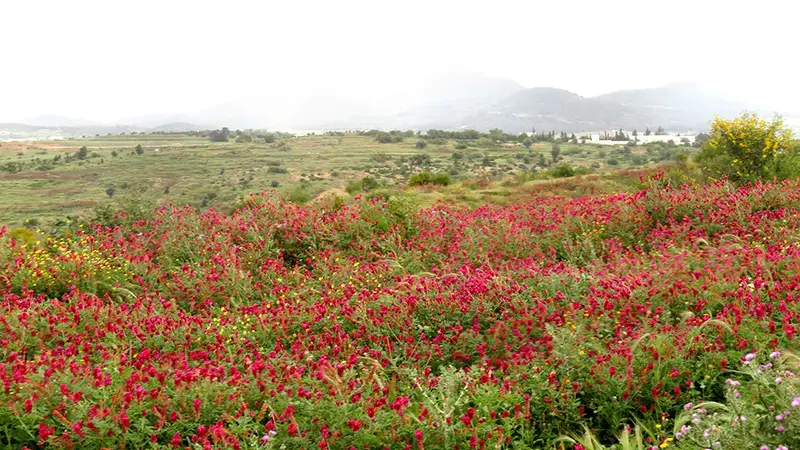Using Native Drought-Tolerant Forage Species for Enhanced Dryland Pasture Restoration

- Mounir Louhaichi - Research Team Leader of Rangeland Ecology and Forages
ICARDA scientists promote the reseeding of indigenous forage legume species for agrosilvopastoral restoration and enhanced land and livestock productivity in Tunisia.
Agrosilvopastoral dryland landscapes are important throughout Africa and Asia for millions of marginal family farmers who depend on them for growing staple crops as well as vital forage for their livestock. Yet due to worsening climate change impacts, increasing population, frequent ecological disasters such as overgrazing, and inappropriate land and water management, the ability of these areas to produce crops and forage is fast declining.
There is an urgent need for improved forage varieties, and cost-effective management actions to reverse agrosilvopastoral degradation and sustainably fill the gap in feed resources, to improve livestock productivity and increase the climate change resilience of agrosilvopastoral communities.
To address this, ICARDA scientists identified and promoted water-efficient, heat- and drought-tolerant forage species as a crucial means of boosting agrosilvopastoral restoration efforts. The project aims to conserve rapidly depleting water resources, improve soil fixation and biodiversity, and maintain grazing at sustainable levels. The innovative approach focuses on optimizing native forage species that are well-adapted to local environments. Crucially, the integrated and participatory approach includes the more active involvement of farmers in decision-making as well as farming community training and awareness-raising on best practices.
The project was carried out in collaboration with the Direction Generale des Forets (DGF) in the Sbaihia, a small-holder farmers community site in the Zaghouan Governorate in semi-arid Tunisia, to assess the efficiency of restoration practices by soil surface scarification and reseeding with native legume species.
A key forage species used is Sulla (Hedysarum coronarium L.) a deep-rooted and drought-resistant forage species. Indigenous to the Mediterranean, it is effective in the biological fixation of sloping land and improves organo-mineral soil fertility, yields, and protein value of cereals. It is also highly palatable to animals, nutritious, and productive.
The project demonstrated a clear beneficial impact towards helping to halt degradation and providing more forages that can sustainably meet the demands of increasing livestock production while lowering import costs of feed. Soil and water erosion was significantly reduced, and the productivity significantly increased in the Sulla reseeded parcels and reached two-fold more than the control parcels.
The approach and the technical package will now be promoted across the country and the region with the support of National Agricultural Research Systems institutions and agricultural ministries, as well as the farming communities themselves.
-------------------------------------------------------------------------------------
IMPACT:
- After the treatment, the total annual aboveground net primary production (ANPP) of rangelands increased by two folds.
- The water productivity recorded in Sulla reseeded rangeland plots increased from 5.5 to 12 kg DM mm-1.
- Overall, the initiative resulted in improved livelihood through the provision of quality fodder and alleviated feeding costs. Furthermore, it enhanced the agrosilvopastoral ecosystem services through reduced water and soil erosion and increased pastoral value.

Further Reading:
Slim Slim, Mounir Louhaichi, Mouldi Gamoun, Serkan Ates, Sawsan Hassan, Oumeima Rhomdhane, Azaiez Ouled Belgacem. (17/2/2021). Assessment of soil surface scarification and reseeding with sulla (Hedysarum coronarium L. ) of degraded Mediterranean semi-arid rangelands. African Journal of Range and Forage Science. https://hdl.handle.net/20.500.11766/12618
Mounir Louhaichi, Kailene Jamel, Slim Slim, Med Bechir Tarchi, Mouldi Gamoun, Sawsan Hassan, Hloniphani Moyo. (30/4/2019). Sustainable Silvopastoral Restoration to Promote Ecosystem Services in Tunisia Project Final Report. https://repo.mel.cgiar.org/handle/20.500.11766/10220
Mounir Louhaichi, Slim Slim, Gouider Tibaoui. (14/9/2018). Managing rangelands: promoting sustainable legume species: Hedysarum coronarium L. a biennial herbaceous legume used for forage in the Mediterranean basin. Beirut, Lebanon: International Center for Agricultural Research in the Dry Areas (ICARDA). https://hdl.handle.net/20.500.11766/8497
